Balkan Food – 28 Traditional Balkan Dishes Not to Miss
Ah, Balkan food.
Neither as famous nor as revered as cuisines from other regions in Europe, traditional Balkan cuisine is pretty much unknown to anyone who isn’t, well, Balkan.
Coming from a region that most people only associate with war and conflict, Balkan food has taken a backseat in the European culinary scene, but is that deserved?
When I travel, one of my primary motivations is food.
From crickets in Vietnam and beetles in Thailand to spleen sandwiches in Sicily and tripe soup in Poland, I never shy away from trying something new, and when I visited the Balkans, I was keen to discover exactly what this lesser-travelled region of Europe had to offer in terms of taste.
Now, after travelling extensively through the Balkans (even living on an Albanian winery at one point) and gorging myself on all of the weird and wonderful Balkan food I could find, I decided it was time to put together a list of traditional Balkan dishes that everybody should aim to try at least once!
So, without further ado, let’s get into it!
Traditional Balkan Food – 28 Balkan Dishes You Need to Try
What are the Balkans?
The Balkans are a group of countries wholly or partially belonging to the Balkan Peninsula, a geographic area in Southeast Europe named after the Balkan Mountains that stretch all the way through Bulgaria to the Black Sea coast.
It is hotly debated which countries constitute the Balkans, and whether they should be defined by their geography, politics or culture, but historians generally state that the Balkan countries are comprised of Albania, Bosnia and Herzegovina, Bulgaria, Croatia, Greece, Kosovo, Montenegro, North Macedonia, Romania, Serbia and Slovenia, with some people considering Turkey a Balkan country as well.
What is Balkan food?
Just what is Balkan food?
When you think about traditional Balkan food, you probably picture a huge platter of grilled meat and not much else.
It is certainly true that Balkan food is very heavy on the meat, but you would be sorely mistaken if you thought that Balkan dishes don’t have anything else to offer.
Due to the Balkans’ long history of foreign rule and internal power struggles, Balkan cuisine is a unique blend of European and Western Asian influences, taking elements from both to create a hearty, filling and delicious type of comfort food that mostly originates from Ottoman cuisine.
In fact, we have the Ottoman rule to thank for the Balkan love of pork – the confrontation with Muslim Turkish invaders led to Balkan people wanting to preserve their traditions and identities, and eating meat that the Turks were not allowed to touch was a way of doing this.
Today, typical Balkan cuisine generally consists of minced and cured meats, stuffed vegetables, domestic cheese, stews and crusty bread. Flavours come from pickled vegetables and hot peppers, and Balkan dishes are usually seasonal and prepared with local products.
It is also important to note that many countries in this region have access to the Adriatic coast, meaning that fish and seafood dishes are incredibly popular in places such as Croatia, Montenegro and Albania.
In the Balkans, ‘farm to table‘ is exactly what it sounds like, and no matter where you are in the Balkans, you will find strong similarities on menus all over the region, albeit with slight regional twists here and there.
28 Traditional Balkan Dishes You Need to Try
1. Tavče gravče
Tavče gravče are traditional baked beans that are cooked and served in an earthenware pot, and unsurprisingly, they’re a damn sight more tasty than Heinz!
This dish is made by cooking fresh butter beans in a sauce flavoured with onion, salt and pepper, red paprika and bay leaves.
One of North Macedonia’s staple dishes, tavče gravče is also commonly found in Serbia and Bosnia as well.
I actually had tavče gravče a few times at Te Nazi in Pristina, Kosovo, so I guess it can really be found anywhere!

2. Šopska salata
Traditionally hailing from Bulgaria and North Macedonia, Šopska salata is the quintessential Balkan salad and you will find it absolutely everywhere in the Balkans.
It is a simple and fresh salad that is typically served as a side dish and consists of chopped tomatoes, cucumber and onion topped with white brine cheese. Seasoning is simple, with just a little salt, extra virgin olive oil and maybe some vinegar.
This salad is perfect for those hot summer afternoons when you want a break from the stodgier Balkan foods, and I would often order a Šopska salad for my lunch during my time in the Balkans.

3. Ćevapčići/Ćevapi
If there was one thing on this list that could take the prize for the most traditional Balkan food, it would be ćevapi, also known as ćevapčići.
Ćevapi are a kind of skinless sausage or spicy minced meatball, made from lamb, beef or pork and well grilled.
Usually served in groups of five to ten pieces, ćevapi can be paired with fried potatoes or bread and chopped onions, kajmak (a special type of sour cream), and ajvar, a pepper-based condiment made from red bell peppers.
If you plan on visiting the Balkans and want to try some ćevapi, don’t worry about finding it – it will certainly find you, and trust me when I say that you will eat so much ćevapi in the Balkans that you may even start to resemble one!
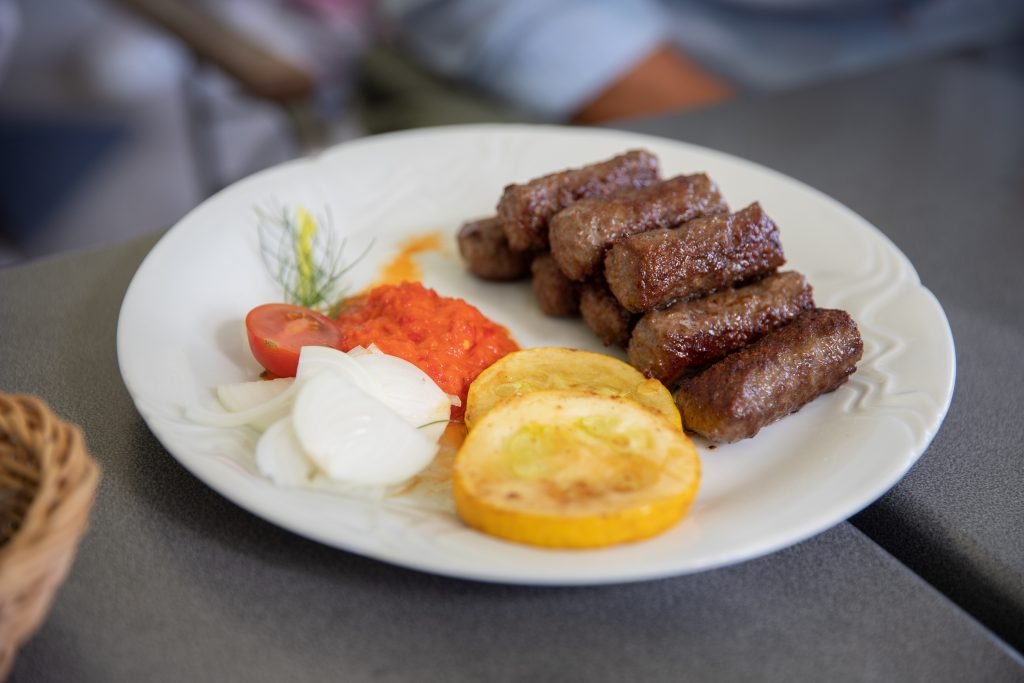
4. Burek
The Balkan equivalent of an English pasty, burek (or byrek) is a filo-pastry that is prepared in a large pan and stuffed with goat’s cheese, spinach, potato, minced meat or even mushrooms (although the latter is by far the least common).
One burek is cut into smaller pieces after baking and served as individual pastries, common in bakeries as a cheap and hearty breakfast food that will set you up for the day.
Aside from ćevapi, burek is probably the most popular Balkan foods there is.
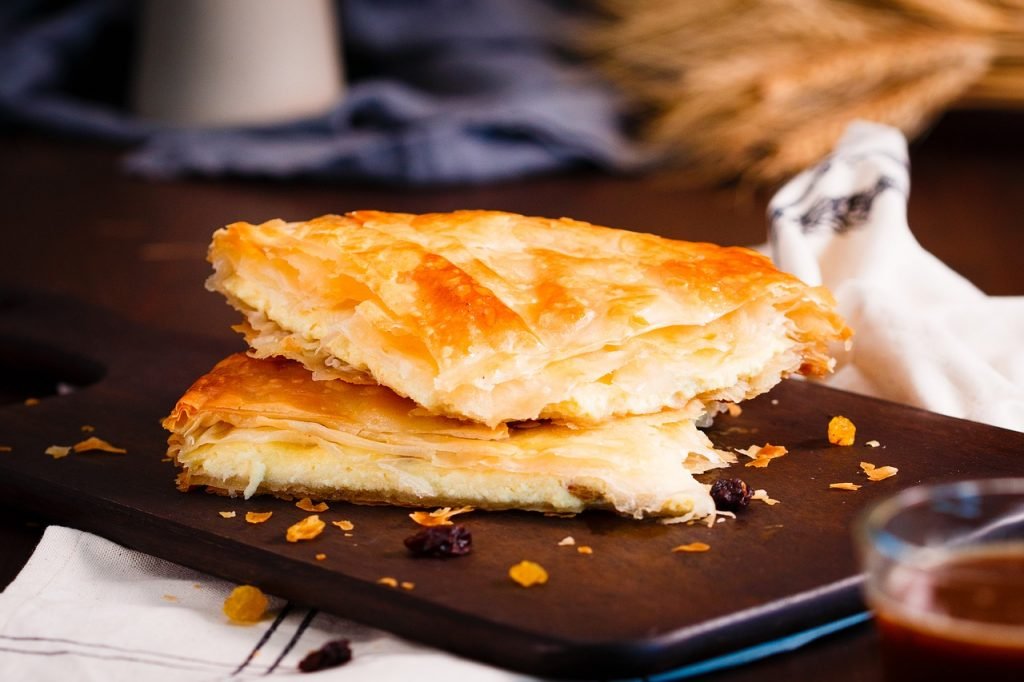
5. Rakija
Although it’s technically a drink, I couldn’t write a post about traditional Balkan food without including the infamous RAKIJA, a kind of fruit brandy produced all over the Balkans that starts at about 40% ABV but can go much, much higher.
Rakija comes in all different flavours, from honey (my favourite) to quince (my least favourite), and the plum rakija, which is the ‘plain’ or basic version.
It is practically a religion to drink rakija in the Balkans, and unless you’ve been utterly defeated by rakija at least once, you haven’t been to the Balkans.
6. Pleskavica
Ah, the Balkan burger, pleskavica!
A pleskavica is a spiced meat patty made of pork, beef or lamb, which is well grilled on both sides and usually served with chopped onions (raw), kajmak and fries. In some parts of the Balkans, it is served inside a big flatbread, like a burger.
Pleskavica can be stuffed with cheese before it is cooked, called pleskavica sharri, and as the meat is grilled, the cheese melts and adds a whole new element to the experience.
Pleskavica is most popular in Serbia, Bosnia and Herzegovina, North Macedonia, and Kosovo.

7. Štruklji
Štruklji are traditional Slovene rolled pastries that can either be sweet or savoury, and they are similar to dumplings.
Typical štruklji fillings include local ingredients like cottage cheese, apple, poppy seed, tarragon and walnut, and they can be steamed, boiled, fried or baked, depending on your preference!
Savoury štruklji are often served with meat and gravy, and dessert štruklji tend to be topped with breadcrumbs.
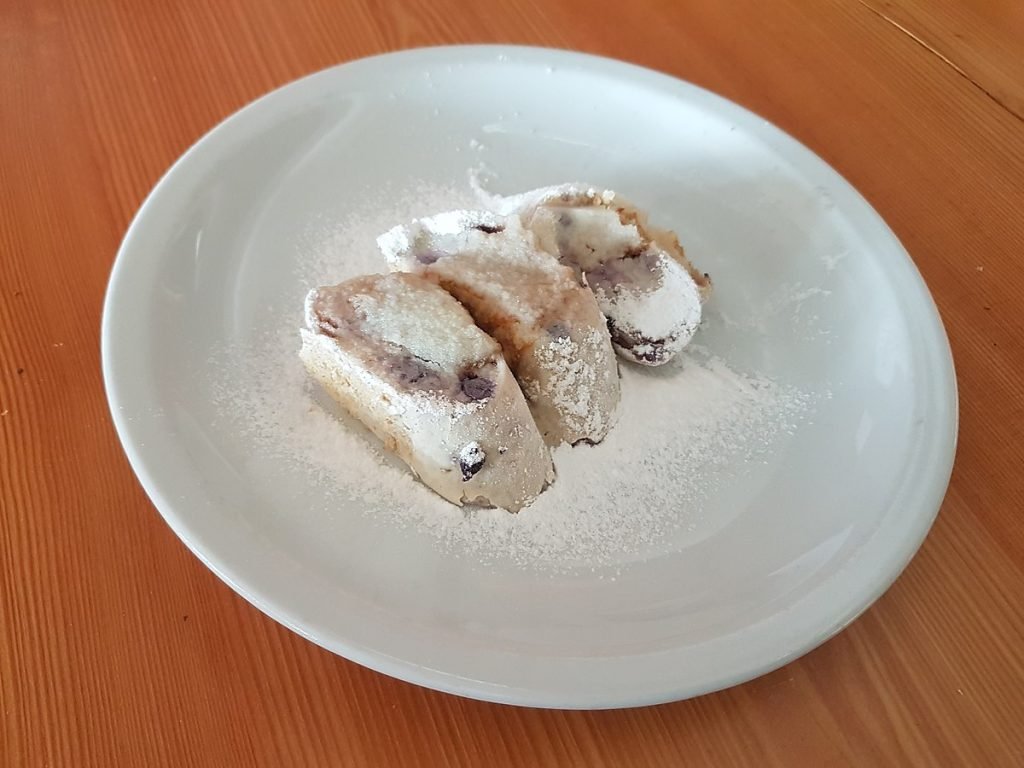
8. Banitsa
Banitsa is a traditional Bulgarian dish made from whisked eggs, natural yoghurt and crushed white cheese sandwiched in-between flaky filo pastry which has been baked in the oven.
Popular as a breakfast food, there are many alternatives to the typical cheese filling including spinach, minced meat and pumpkin. Usually, a breakfast banitsa would be served with aryan, which is a savoury yoghurt drink.

9. Mekitsa
Next on our Balkan food list we have mekitsa, another Bulgarian breakfast dish that is made from balls of kneaded dough that are fried, kinda like little donuts or sweet Yorkshire puddings!
Also found in North Macedonia and Serbia, mekitsa are usually dusted with icing sugar and served with jam, honey or white cheese.

10. Sarma
Sarma, which literally means ‘rolled’ or ‘wrapped’ is the name given to cabbage rolls, which differ slightly from place to place.
In Romania, cabbage leaves or vine leaves are stuffed with pork and beef before being rolled up and baked. They are accompanied by a slice of bacon, sauce and side of polenta.
Cabbage rolls in other Balkan countries are made from pickled cabbage and stuffed with rice or bulgur, minced beef and pork, boiled in a tomato sauce with panceta and seasoned with fresh herbs.
If pleskavica is the Balkan burger, then think of sarma as a Balkan burrito!

11. Kajmak
If you’ve been paying close attention, you may have seen me mention kajmak a couple of times in this post.
That’s because kajmak is hugely popular all across the Balkans, and while it isn’t a Balkan food exactly, you will rarely see a meal served without it.
Kajmak is used as a sort of condiment to accompany a range of Balkan dishes (although many Balkan people eat it as an appetiser or for breakfast).
Kajmak is a spreadable, fermented cheese with a slightly sour taste, and it is similar to clotted cream. Kajmak is almost always made at home, and is best eaten when absolutely fresh.
You can expect to see kajmak served with pleskavica and ćevapi, or served inside a pita bread as fast food in Serbia (called lepinja sa kajmakom).
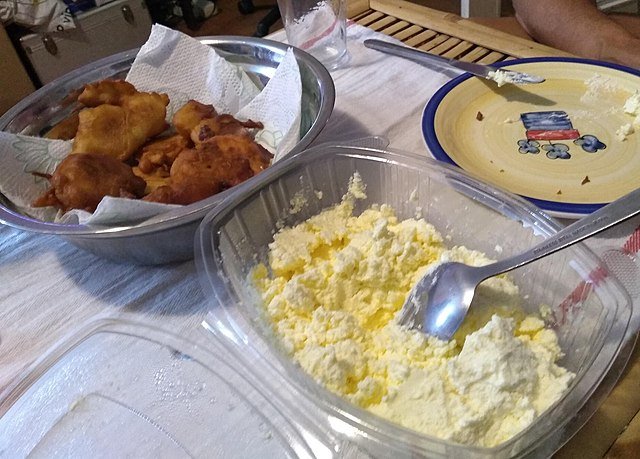
12. Kifle
Thought to be the inspiration for the French croissant, kifle are crescent-shaped bread rolls that are typically salted.
Unlike a croissant, they taste more like a bread roll than a pastry, they do not have a flaky texture, and they are not sweet.
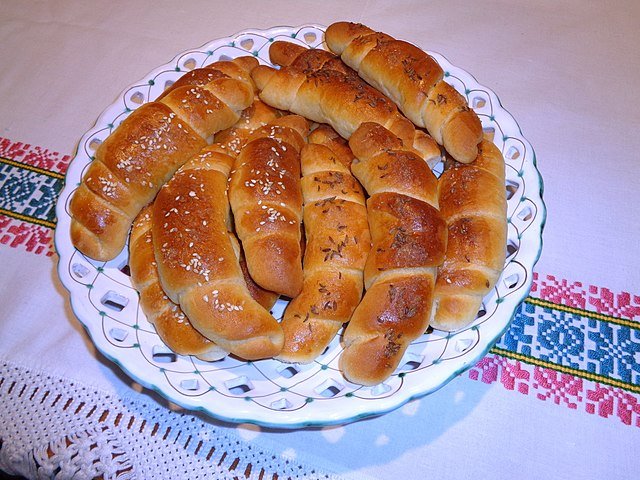
13. Ajvar
A dipping sauce that you may come across even more than kajmak is AJVAR.
Made from sweet red peppers and eggplant, along with garlic, chilli peppers, olive oil and salt, ajvar is an absolute staple of the Balkan diet, and you’d be hard-pressed to find a Balkan household without a stash of ajvar in the pantry.
Depending on your taste, ajvar can be sweet or spicy (I prefer the spicy version), and you can spread it on bread, enjoy it with your grilled meat, or simply eat it as it comes!

14. Punjene Paprike
Punjene paprike, otherwise known as stuffed peppers or dolma, are red or green peppers that have been stuffed with rice, minced beef and various herbs and spices, usually served in a tomato sauce.
Meaning ‘stuffed’ or ‘filled,’ the word dolma can refer to any type of stuffed vegetable, including courgettes, eggplant (I had this a lot in Albania), or tomato.
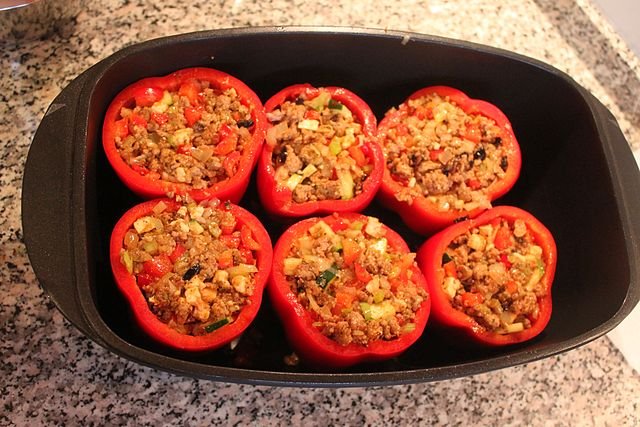
15. Musaka sa Krompirom
While traditional Greek moussaka is a casserole dish made with ground beef, eggplant and egg topped with a tomato sauce, Balkan musaka replaces the eggplant with potatoes, creating a much heavier and more substantial meal. The tomato sauce is often swapped out for cheese, making Balkan musaka an entirely new dish and definitely deserving of its own place on this list!
For me, Balkan musaka tastes a little bit like Shepherd’s Pie, making it the perfect food for those cold winter nights.
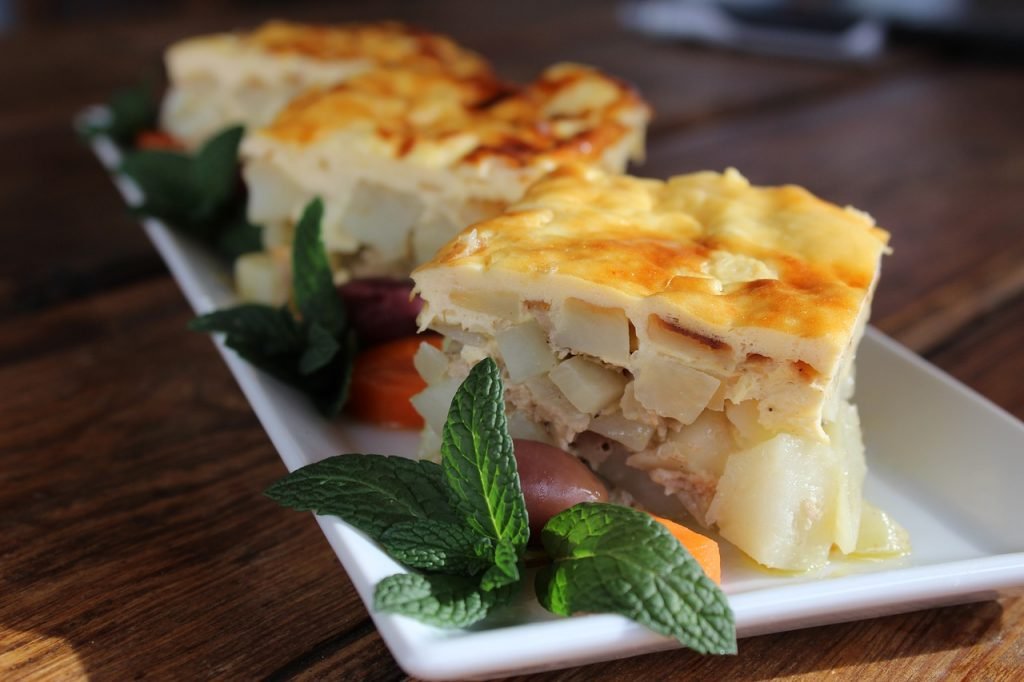
16. Coffee
Coffee culture in the Balkans is huge, to the point where coffee is pretty much a food group in itself.
People in the Balkans drink coffee all day long, whether they’re on a first date, a job interview, a business meeting or even a break up!
Brought into the region in the 16th century by the Ottomans (the first coffee shop in Europe was in Belgrade!), the most traditional type of coffee in the Balkans is what you may know as ‘Turkish coffee,’ but you will hear it referred to as Bosnian coffee, Greek coffee, or simply just domestic coffee in Serbia.
Whatever you want to call it, Balkan-style coffee is unfiltered, making it extremely strong, with a thick texture and a rich flavour.
Unlike espresso in Italy, which is gulped down while standing at the bar, coffee in the Balkans is savoured, and it can take hours to drink a single cup, so sacred is the coffee culture there!
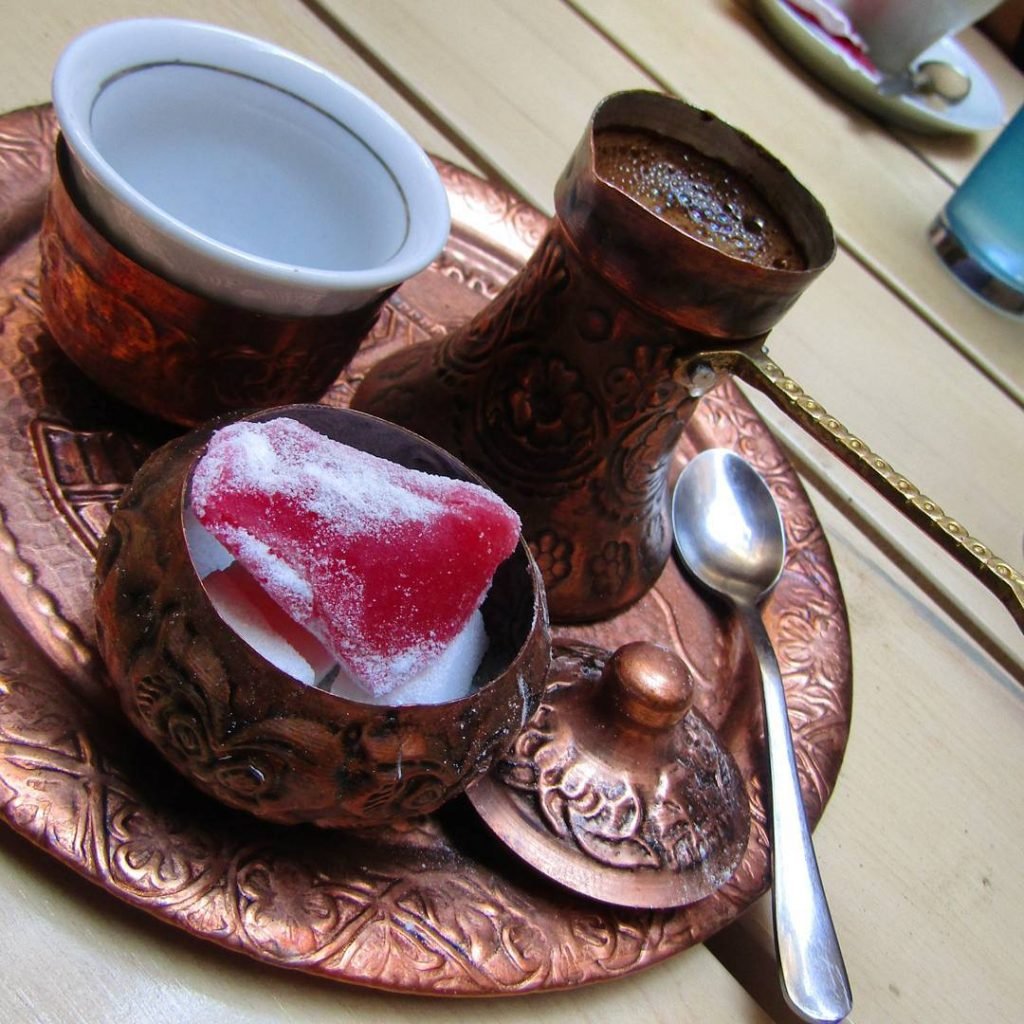
17. Goulash
Although goulash originally hails from 9th century Hungary, each region in the Balkans prepares it in their own special way, and this hearty Balkan food is especially treasured in Serbia.
However, wherever you go, goulash is a stew made with meat (in Serbia goulash is extra heavy on the meat), potatoes, vegetables and herbs, and in the Balkans it is typically cooked over a wood fire.
The meat used tends to be beef, veal or pork, although in Croatia is it common to use game meats such as venison or wild boar as well.
Other ingredients can include bacon, onions, paprika, lard, carrots, porcini mushrooms, bell peppers, garlic, parsley, tomatoes and whatever else is in the pantry waiting to be used up!
Goulash can be served with bread, pasta, polenta (Croatia), macaroni (Serbia) or mashed potato.
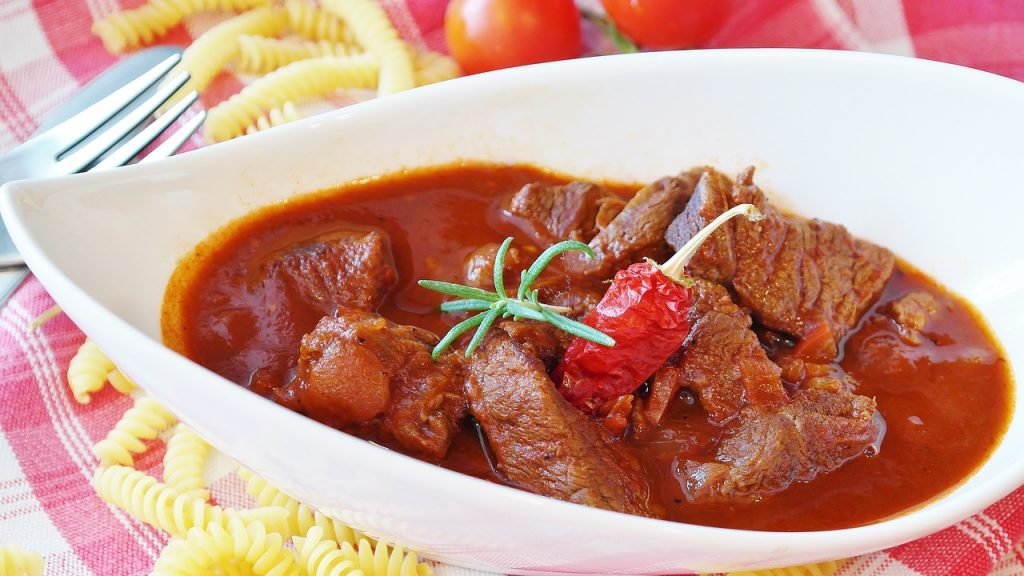
18. Grilled fish
One of my favourite things in life is to enjoy a white fish, grilled over hot charcoal and drizzled with lemon, along with a cool glass of white wine.
Luckily for me then, grilled fish is a summer staple in many regions in the Balkans.
Along the Adriatic coast you will find sea bass, monk fish and sardines, which are served whole and seasoned simply with domestic olive oil, lemon and herbs, with a sprinkle of salt.
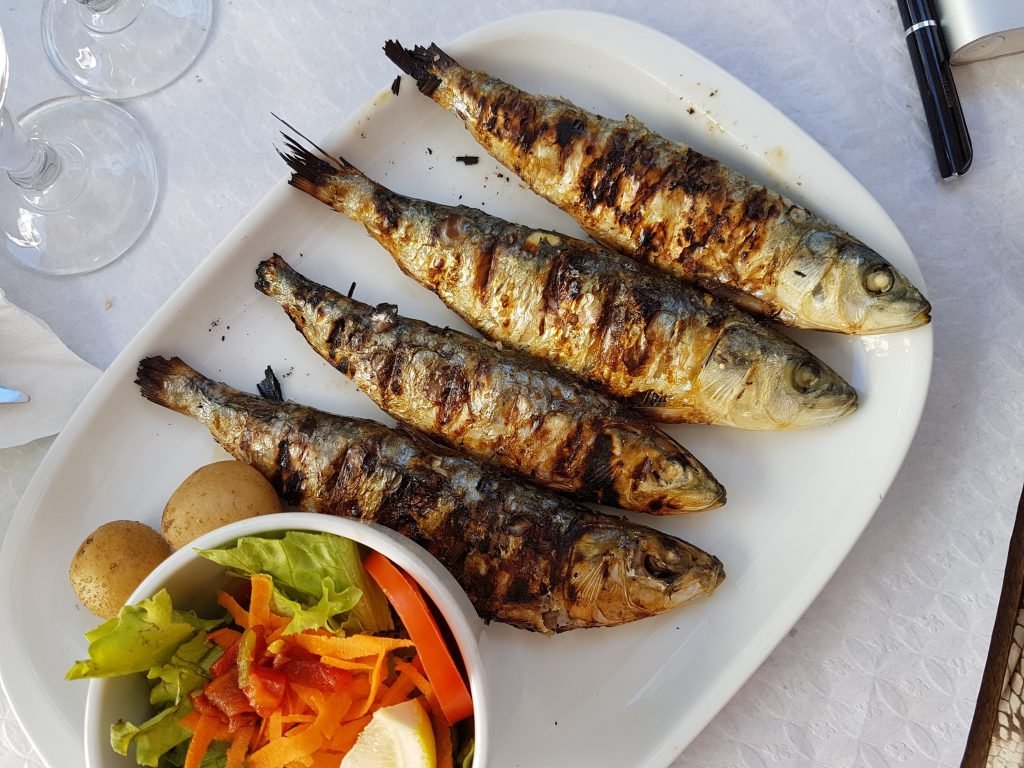
19. Mussels
While mussels will not be a new or unusual food for many, mussels in the Balkans are simply delicious.
Highly popular in Croatia and Montenegro, mussels are often cooked buzara style with white wine, garlic, parsley, breadcrumbs and olive oil, and served with white wine.
In other Balkan regions, mussels are mainly steamed and cooked in a tomato and garlic sauce.
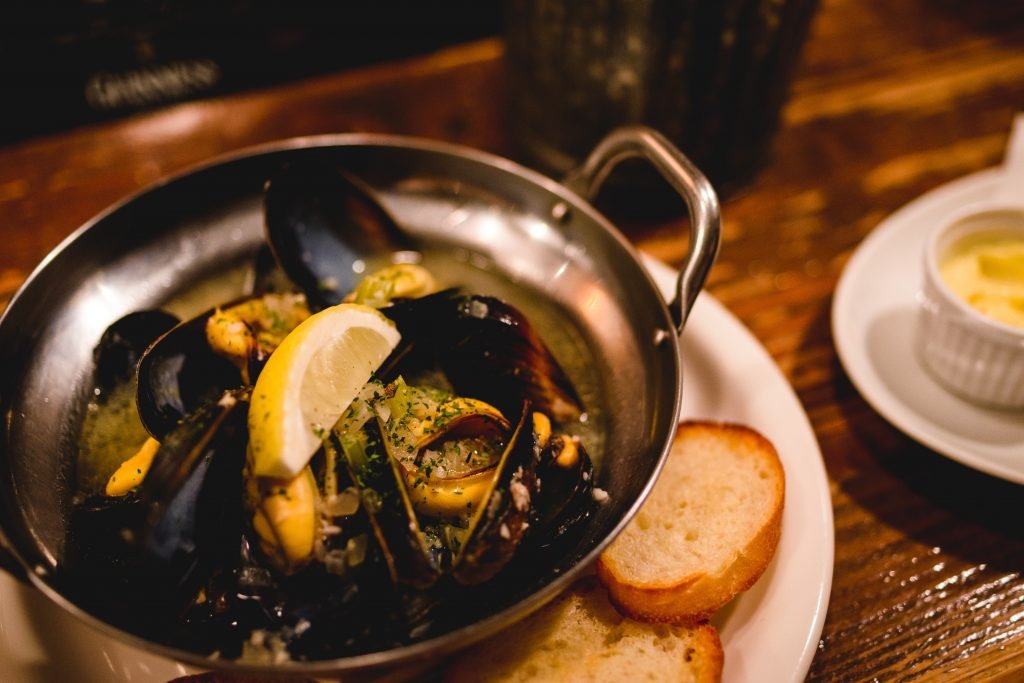
20. Cuttlefish risotto
Popular in the Dalmatian region of Croatia, Albania, Greece and Montenegro, cuttlefish risotto is a black risotto with cuttlefish and its black ink, which gives the dish its creamy texture, and of course, its colour. This Balkan dish is then topped with parsley and parmesan cheese.
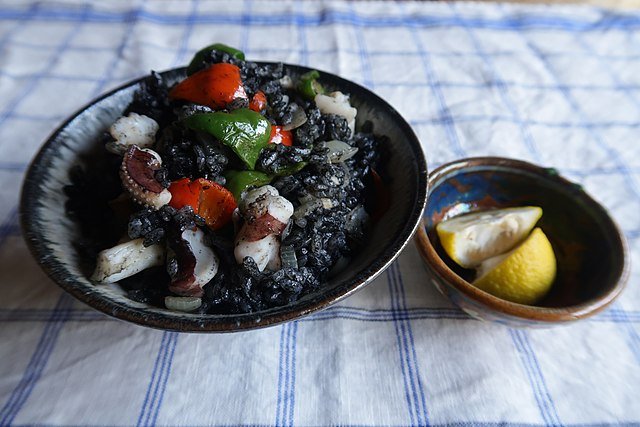
21. Grilled vegetables
While not exclusively a Balkan food in themselves, it is very common in the Balkans to order a plate of grilled veggies as a side dish, drizzled with domestic olive oil and seasoned with garlic and fresh herbs.
Most commonly seen are bell pepper, courgette, eggplant, tomato, onion, chili pepper and mushroom.
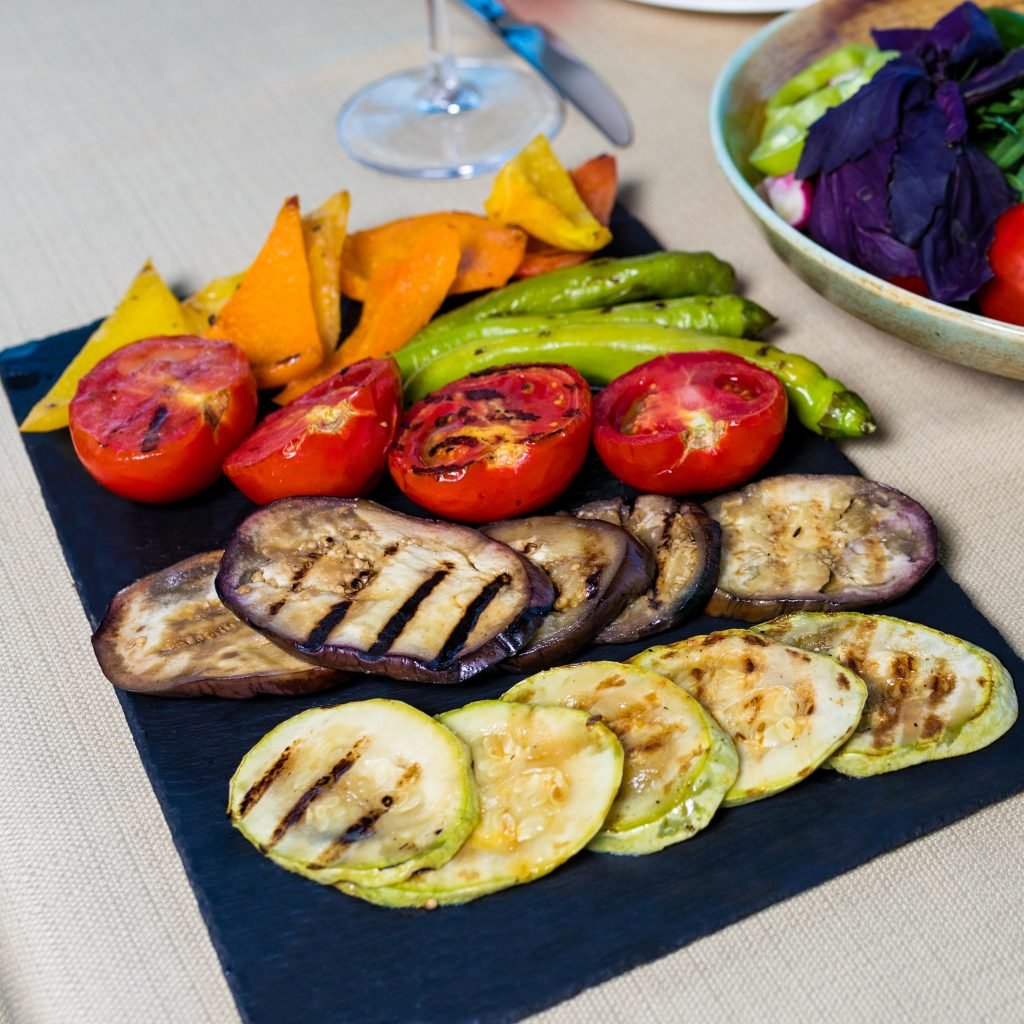
22. Tarator soup
Tarator is an unusual soup in that it is served cold. Made from cucumber and natural yoghurt with garlic and dill to add flavour, it is refreshing in the hot summer months, similar to gazpacho in Spain.
Tarator soup is popular in Bulgaria and Albania.

23. Blitva
When I lived in Kotor, Montenegro, this dish was known as ‘Dalmatian potatoes,’ but if we’re being technical about it, it is actually blitva and potatoes.
Blitva is the name for swiss chard, a dark leafy green similar to spinach and kale, and it is served with boiled potatoes and lashings of garlic, oil and butter, topped with freshly ground black pepper.
Blitva is traditionally a peasant food but these days it is usually served as a side dish, typically with fish, but the further inland you go, it is a common accompaniment to meat, and sometimes even has pieces of bacon mixed in – the perfect dish if you’re visiting Montenegro in winter!

24. Octopus salad
Another Balkan delight popular along the Adriatic coast, octopus salad is a simple salad that is generally served as a starter.
Comprised of cold octopus with chopped onion, garlic, a drizzle of lemon and olive oil, this is further proof that you do not need a million sophisticated ingredients to make a spectacular Balkan dish.
The emphasis here is on quality, locally-sourced produce that is in-season and as fresh as can be.
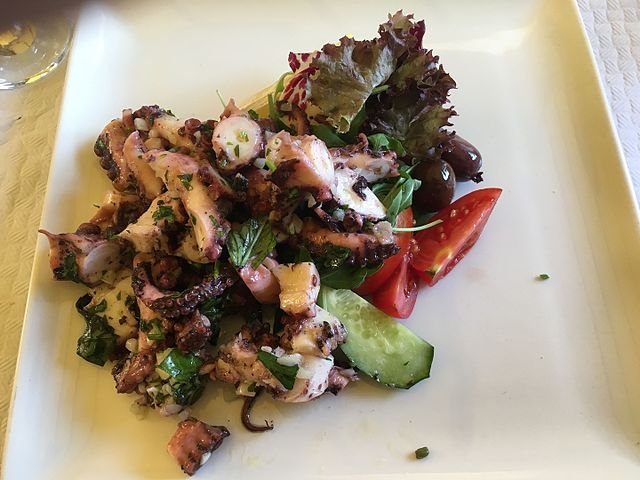
25. Pršut
If you like Balkan food but are missing your Italian favourites, then pršut may just be the answer.
Pršut is dry-cured ham, served uncooked, and is very similar to Italian prosciutto. It can be served smoked or unsmoked – Dalmatia, Serbia and the Herzegovina region of Bosnia tend to smoke theirs, while pršut from Istria, Krk and Slovenia tend not to serve smoked pršut.
I was actually lucky enough to try the most famous and revered pršut out there, Njeguški pršut, in the mountain village of Njeguški, Montenegro.
Taking around a year to prepare, the ham is cured with sea salt for around 3 weeks, before being pressed for another 3 weeks to expel any excess liquid. It is then smoked and hung out to dry in the fresh mountain air until it is ready to be served.
26. Baklava
Although not exclusive to the Balkans, Baklava is nevertheless a very common dessert across the region, and so it would be unfair not to include it on an article about Balkan food!
Baklava is a pastry dessert made with layers of filo pastry that are filled with chopped nuts (walnuts, pistachios or hazelnuts) and soaked in a syrup traditionally made from water, sugar and lemon.

27. Qifqi
When I arrived in Gjirokastra, Albania, the UNESCO city of a thousand steps, the first thing that I was told I had to do was try qifqi, a local speciality that is similar to arancine, a street food popular in Sicily.
Qifqi are rice balls, held together with eggs and seasoned with herbs before being fried in olive oil. Perfect as a snack or appetiser, you probably won’t find qifqi outside of Gjirokastra so be sure to try them while you’re there or risk missing out!
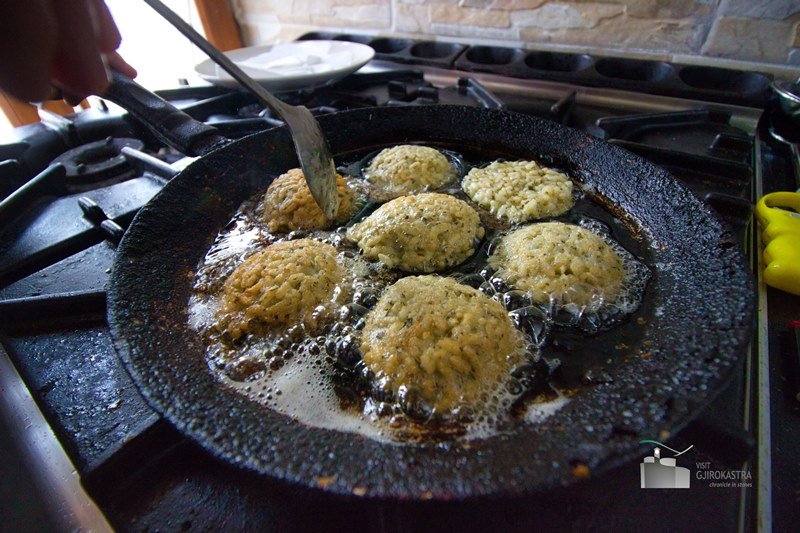
28. Trilece
Trilece is a very light and very sweet Balkan sponge cake, which is made with 3 different types of milk – evaporated milk, condensed milk and heavy cream – and topped with caramel.
It has a kind of soggy texture similar to the sponge part of a tiramisu, and probably isn’t for those of you without a sweet tooth – I only tried a bite of my boyfriend’s but even that was too much for me!
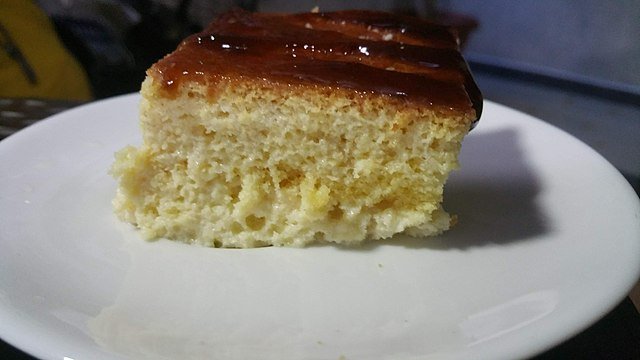
Traditional Balkan Food | Final Thoughts
So, that just about brings me to my mega list of traditional Balkan dishes that you have to try!
While it may seem at first to be a very meat-centric cuisine, that there is truly something in Balkan cuisine for everyone.
While huge platters full of grilled meats are definitely the order of the day, you don’t have to look far to find an abundance of colourful salads, stuffed veggies and the freshest seafood you will ever taste.
Everything in the Balkans is just brimming with flavour, from the salty goat’s cheese that accompanies almost every meal to that juicy tomato in your side salad, and only in the Balkans have I ever truly experienced slow food.
The Balkans may not top the lists of many chefs and food bloggers, but I wholeheartedly believe that Balkan food has a lot to offer, and I’m already counting down the days until I’m back in Albania with a glass of wine in my hand and a pile of food on my plate.
You May Also Like
Balkan Food
Guide to Albanian Coffee Culture
Greek Food Guide
Bulgarian Food Guide
Best Restaurants in Kotor, Montenegro
Living on an Albanian Winery
Why Rakija is the Best Drink in the World
The Rest of the World
Guide to Georgian Chacha
Guide to Georgian Amber Wine
Guide to Polish Food
Guide to Sicilian Food
Guide to Breakfast in Italy
Guide to Breakfast in Morocco
Portuguese Coffee Culture
Guide to Valencian Food
Traditional Irish Food Guide
Guide to Czech Food
Olive Tourism Deep Dive
Guide to Roman Food
Guide to Andalucian Food
If you liked this article and would like to support my work, please click the button above to donate a couple of bucks and buy me a coffee. The ad revenue that I receive on this website is minimal, so support from my readers enables me to keep creating content that you (hopefully!) love to read.

